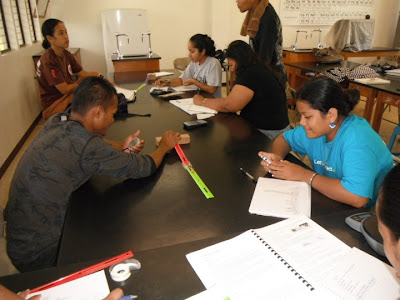Explorations of momentum, Hooke's law
Laboratory four began as I have done so in the past, with an introduction to the behavior of marbles on a ruler. I usually lead off with the students gathered around observing a simple marble momentum conservation system.
Five to seven marbles sit touching each other on the flat portion of a marble track. The marble track is made of two plastic rulers with grooves to guide the marbles. One to four marbles are released from an elevated end of the track. I demonstrated that "marbles in" appear to equal "marbles out." I noted that this also means that "mass in" must roughly be "mass out."
I also qualitatively demonstrated that "speed in" appeared to be related to "speed out." This was all done qualitatively, not quantitatively.
This term I deployed an electronic mass scale to simplify massing the marbles. In addition, in a break from prior terms, I demonstrated ways to measure speed in and speed out. This term provided more structure, was more directive, than prior terms. Different classes seem to start differently, I have yet to gel the design of this laboratory.
Laboratory five explores whether an elastic band is a Hookean material - a linear elastic material. This laboratory also uses marbles, thirty of them.
The elastic seems to vary in behavior in part according to the length of the elastic. Some data is linear, some is bilinear, and others form smooth almost logarithmic curves of extension versus mass. The system is modeled as F = kx with downward extension taken as positive, hence the +k.
Perihsa times
Seylyn Johnston on the stopwatch
Lizmay working calculations
Jessica, Hanna, and Palikkun crunch some numbers
This term I deployed an electronic mass scale to simplify massing the marbles. In addition, in a break from prior terms, I demonstrated ways to measure speed in and speed out. This term provided more structure, was more directive, than prior terms. Different classes seem to start differently, I have yet to gel the design of this laboratory.
Ceyleen also calculating results
Laboratory five explores whether an elastic band is a Hookean material - a linear elastic material. This laboratory also uses marbles, thirty of them.
Jessica and Palikkun, Joyceleen in the background
Lotrynes records data for Joyceleen
The elastic seems to vary in behavior in part according to the length of the elastic. Some data is linear, some is bilinear, and others form smooth almost logarithmic curves of extension versus mass. The system is modeled as F = kx with downward extension taken as positive, hence the +k.











Comments
Post a Comment